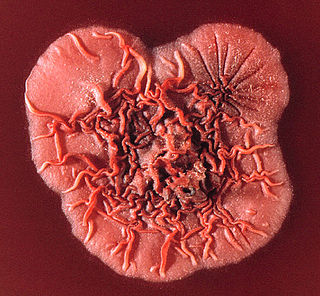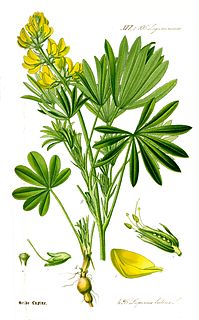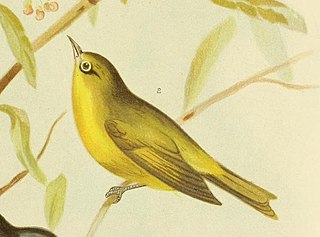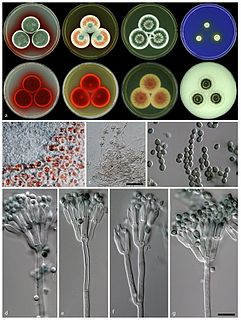
Penicillium is a genus of ascomycetous fungi that is part of the mycobiome of many species and is of major importance in the natural environment, in food spoilage, and in food and drug production.

Talaromyces marneffei, formerly called Penicillium marneffei, was identified in 1956. The organism is endemic to southeast Asia where it is an important cause of opportunistic infections in those with HIV/AIDS-related immunodeficiency. Incidence of T. marneffei infections has increased due to a rise in HIV infection rates in the region.

Stippling is the creation of a pattern simulating varying degrees of solidity or shading by using small dots. Such a pattern may occur in nature and these effects are frequently emulated by artists.

The Eurotiomycetes are a class of ascomycetes within the subphylum Pezizomycotina.

The Trichocomaceae are a family of fungi in the order Eurotiales. Taxa are saprobes with aggressive colonization strategies, adaptable to extreme environmental conditions. Family members are cosmopolitan in distribution, ubiquitous in soil, and common associates of decaying plant and food material. The family contains some of the most familiar fungi, such as Penicillium and Aspergillus. It has been proposed that the family should be split into the three families Aspergillaceae, Thermoascaceae and Trichocomaceae.

Keyesville is an unincorporated community in Kern County, California. It is located 2 miles (3.2 km) west of Lake Isabella and the Kern River Valley, at an elevation of 2,848 feet (868 m). Keyesville, founded in 1854 is named for Richard M. Keyes, whose discovery of gold in 1853 started the Kern River Gold Rush.

Micrococcus luteus is a Gram-positive, to Gram-variable, nonmotile, coccus, tetrad-arranging, pigmented, saprotrophic bacterium that belongs to the family Micrococcaceae. It is urease and catalase positive. An obligate aerobe, M. luteus is found in soil, dust, water and air, and as part of the normal microbiota of the mammalian skin. The bacterium also colonizes the human mouth, mucosae, oropharynx and upper respiratory tract. It was discovered by Sir Alexander Fleming before he discovered penicillin in 1928.

Suillus luteus is a bolete fungus, and the type species of the genus Suillus. A common fungus native to Eurasia, from the British Isles to Korea, it has been introduced widely elsewhere, including North and South America, southern Africa, Australia and New Zealand. Commonly referred to as slippery jack or sticky bun in English-speaking countries, its names refer to the brown cap, which is characteristically slimy in wet conditions. The fungus, initially described as Boletus luteus by Carl Linnaeus in 1753, is now classified in a different family as well as genus. Suillus luteus is edible, though not as highly regarded as other bolete mushrooms, and is commonly prepared and eaten in soups, stews or fried dishes. The slime coating, however, may cause indigestion if not removed before eating.
Talaromycosis is an infection caused by Talaromyces marneffei. The disease is endemic exclusively to southeast Asia. The disease usually affects people with a weakened immune system; healthy people are rarely affected. Talaromycosis often presents with non-specific symptoms and with skin bumps that are usually small and painless and usually affect the face and neck. The infection is thought to be acquired by inhaling the pathogen from the environment, however, the environmental source of the organism is not known. The disease is treatable with antifungal medications. The disease is likely to end in death if not treated.

Calochortus luteus, the yellow mariposa lily, is a mariposa lily endemic to California.

Lupinus luteus is known as annual yellow-lupin, European yellow lupin or yellow lupin. It is native to the Mediterranean region of Southern Europe.
The Spenceville Wildlife Area is an 11,448-acre (46.33 km2) wildlife preserve managed by the California Department of Fish and Wildlife. It is located in the Sierra Nevada Foothills, within Nevada County and Yuba County of northern California.
Coniella fragariae is a plant pathogen. It is known to be pathogenic on eucalypts in a number of countries, including Brazil, India, China and Australia. Chemical constitution study showed azaphilone were the main secondary metabolites from this fungus.
The yellow steppe lemming is a species of rodents in the family Cricetidae. It is found in China, Kazakhstan, and Mongolia. Its natural habitat is temperate desert.
Eolagurus is a genus of rodent in the family Cricetidae. It contains the following species:

The canary white-eye or yellow white-eye is a species of white-eye endemic to northern Australia in subtropical or tropical mangrove forests. Its common name reflects the circle of white feathers around its eye.

Talaromyces is a genus of fungi in the family Trichocomaceae. Described in 1955 by American mycologist Chester Ray Benjamin, species in the genus form soft, cottony fruit bodies (ascocarps) with cell walls made of tightly interwoven hyphae. The fruit bodies are often yellowish or are surrounded by yellowish granules. A 2008 estimate placed 42 species in the genus, but several new species have since been described.
Coniella is a fungus genus in the family Schizoparmeaceae. This genus Coniella are reported as a typical plant pathogenic fungi for grape, eucalyptus and several plant. It mainly found in Europe, Asian, also South Africa. less report in American, only one paper published new spaces founded. In the chemical constitution study, two paper reported azaphilone are the main metabolites.
Penicillium chermesinum is an anamorph fungus species of the genus of Penicillium which was isolated from soil from Nova Scotia in Canada.Penicillium chermesinum produces plastatin, luteosporin, xanthomegnin, azaphilones, p-terphenyls and costaclavine.
BW284C51 is a selective acetylcholinesterase inhibitor. It is also a nicotinic antagonist.












